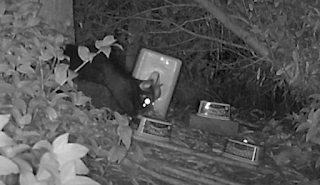Andrew Hornblow, who is based in Opunake has been responsible for the key elements of the electronics in this project and we have recently looked at ways to refine the project from a focus on sound lures to include a focus on LED lights and simple robotic movement - and its affect on attracting possums.
To this end we have switched deployment site one to focus on using Andrew's idea for an LED setup. This this features a breadboard, basic chip (Pickaxe) and a simple LED light that is timed to go off to read the volume level of the three AA batteries that are powering the unit. This flash of the voltage shows a long and short pattern which is transmitted to the LED - causing a seemingly random flash. We have four different colours that we are testing. For the purpose of the initial test we have grouped four different LEDs (and yes that is a margarine container that is housing the unit).The units are deployed with the back left unit being green, the back right being blue, the front left being yellow and the front right being red. The units are reading the light level from the LED and do not operate during daylight. The set up can be shown below at deployment site one.
The reason for the displacement of the four units from the pattern that is described above was that on the first night of deployment interest in the LEDs was shown and possums moved the (lightweight) units around. There is no trap associated directly with the units - the key test element here is to see if the blinking LED's will create an interest for the possums to venture to the site and will this be any different from what we have experienced by using a sound lure at this location.Obviously it is very early in this trial but in the first night we have had ten activations at the site. This is mid range for what we have been experiencing recently.
However the first night did see the return of a female with a baby to the site (shown in the photo to the left) which showed clear interest in the yellow LED (by pushing its nose against the unit and moving it when it activated). There was no visit by the large dark brushed tailed possum that has frequented the site over the past several months. These are both trends and data that we will look to analyse moving forward to see if we can determine the difference that an LED might make. One thing that we can already state is that the LED's by themselves do not appear to be a source of fear for the possums. We had several visits to the site and the Timms trap (which has no sound lure attached so is in essence operating as it is intended) was activated by a trapped possum which was caught at 2:05am - of note there were no further visits to the site after this capture. This contrasts slightly with our last capture on the night of the 1st of January (which was at 1:48am) when there were a further five visits after our last capture the last of which occurred at 4:12am.




No comments:
Post a Comment